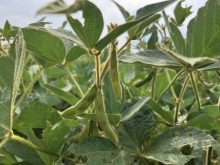Mistaken identity can be a problem with diseases in soybeans. How often is soybean cyst nematode dismissed as a nutrient deficiency or a planter issue?
Like other root rot diseases, charcoal rot in soybeans is similar in above-ground appearance and the conditions in which it can infect plants.
Why it matters: Charcoal root rot can be easily missed, and under the right conditions it can impact yield.
Read Also

The forced Japanese-Canadian farmers of the Second World War
Manitoba’s sugar beet farms drew on displaced Japanese-Canadians from B.C. during the Second World War
Poor soil fertility and compaction can promote stress on the plant, particularly under hot and dry conditions, and charcoal rot usually appears later in the season as the plant starts to mature.
Charcoal rot in soybeans has been in the province for 20 to 30 years and ranks below soybean cyst nematode, sudden death syndrome, Phytophthora root rot or sclerotinia in terms of yield losses or intensity.
According to the Crop Protection Network, it’s caused by a soil-borne fungus that produces tiny black fungal structures – microsclerotia – that can appear in the stem pith, on the surface of taproots and on lower stems.
Visually, charcoal rot causes a light grey or silver discolouration at the stems and on taproots. It’s possible to scrape that away, revealing microsclerotia that look like black specks of pepper embedded in diseased tissue.
Although infection can occur very early in the season, states the network, symptoms appear after flowering. The disease is most yield-limiting under hot and dry conditions.
This past growing season, parts of the province saw hot and dry conditions shortly after planting but excessive rain through much of June, July and August made other diseases more of a problem. That doesn’t mean charcoal rot can be ignored or discounted.
“It’s one that’s more common, or at least we find it more in the southwest, so Essex, Chatham-Kent, Elgin and along the Lake Erie shoreline,” says Albert Tenuta, field crops pathologist with the Ontario Ministry of Agriculture, Food and Rural Affairs.
“The results look very similar to what we see with Phytophthora root rot and even white mould, where you see these dead plants in the field. If you don’t check them, you might write them off as Phytophthora or another stem disease.”
In 2023, a number of soil samples were collected and processed through the Pest Diagnostic Lab at the University of Guelph. Many have come back with Phytophthora root rot, fusarium root rot, rhizoctonia and pythium – all typical root rots that might be expected.
“But this year, we’re seeing a little more frequency on charcoal root rot,” says Tenuta. “It’s not one that we’ll see every year but when there are hot, dry conditions, those are favourable conditions in those fields that have a history of the disease.”
More prevalent in U.S.
Charcoal rot is a curious contrast in parts of the U.S. It’s not as prominent in terms of soybean diseases yet it’s more pronounced in hot and dry conditions. When that environment is heightened, fertility and compaction stresses compound the disease’s impact.
“Charcoal rot can have an impact on yield,” says Tenuta, noting its presence in Ontario is sporadic.
“But it’s in southern parts of Indiana, Illinois, Kentucky, Tennessee, Kansas and southern Nebraska. Those are areas where charcoal rot is much higher in occurrence and severity. If we suspect that we’re going to see more of these hotter, drier conditions over time, we may start seeing more charcoal rot in the province, as well.”
Management practices
As far as tolerance or resistance to charcoal rot, Tenuta says little is known and management comes down to controlling moisture in the field through tile drainage or irrigation. Tillage is another tool.
“No till is one practice that’s been utilized in the U.S. because it conserves moisture,” he says. “But in terms of seed treatments, there aren’t too many that target charcoal rot only, and I would say that we have susceptible germplasm.”















